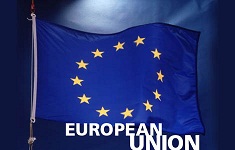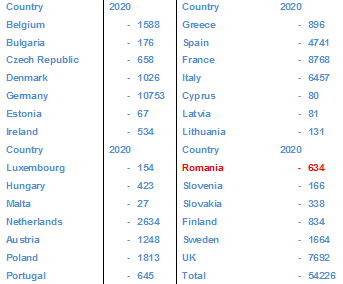 March 26, 2012 – If adopted as a new own resource of the EU budget the financial transaction tax (FTT) will significantly reduce the contributions of member states to the EU budget. According to estimates presented by the European Commission, Member States’ contributions would be slashed by €54bn in 2020. Romania’s contribution will be reduced with €634 mil.
March 26, 2012 – If adopted as a new own resource of the EU budget the financial transaction tax (FTT) will significantly reduce the contributions of member states to the EU budget. According to estimates presented by the European Commission, Member States’ contributions would be slashed by €54bn in 2020. Romania’s contribution will be reduced with €634 mil.
The Commission proposes that two thirds of the revenues of the FTT go to the EU budget, reducing by the same amounts Member States’ contributions based on their GNI, with the remaining one third being retained by Member States. Therefore, every euro levied with the FTT will ultimately benefit the Member States, whether through direct revenue collection or through a reduction of contributions to the EU budget.
 The financial sector does not pay VAT and has received massive support by taxpayer’s money, said Financial Programming and Budget Commissioner Janusz Lewandowski. Taxing the transactions of all financial institutions at rates as low as 0.01% is only fair. Furthermore, the estimated revenue which the tax would generate by 2020 can only be welcome by cash strapped governments across the EU.
The financial sector does not pay VAT and has received massive support by taxpayer’s money, said Financial Programming and Budget Commissioner Janusz Lewandowski. Taxing the transactions of all financial institutions at rates as low as 0.01% is only fair. Furthermore, the estimated revenue which the tax would generate by 2020 can only be welcome by cash strapped governments across the EU.
If the Commission proposals are adopted, the individual Member States could reduce their direct contributions based on GNI to the EU budget in 2020 in the following way.
Estimated reduction of GNI contribution to the EU budget by Member State
(in million Euros)

How the calculation was made
Using data for 2010, the European Commission estimates that the Financial Transaction Tax would raise €57bn. Assuming that the volume of taxable transaction will follow the evolution of the EU GNI, that €57bn will become €81bn in 2020. The European Commission suggests that two thirds of that €81bn be used to finance EU expenditure, which amounts to €54.2bn. Based on the Commission’s proposal, the GNI national contributions would be €110bn in 2020 without an FTT. With an FTT Member States could therefore save 50% of their GNI contribution for the EU budget. The table on the previous page illustrates how many Euros each Member State would save in GNI contribution in the year 2020.
Countdown
On 29 June 2011 when presenting the proposals for the 2014-2020 Multiannual Financial Framework the Commission argued that the system for financing the multi-annual EU budget should become more transparent and fairer and reduce the Member States’ contributions. The financial transaction tax was proposed as a new own resource.
On 28 September 2011 the Commission proposed a directive on a financial transaction tax to be levied on all transactions between financial institutions when at least one party to the transaction is located in the EU. The exchange of shares and bonds should be taxed at a rate of 0.1% and derivative contracts, at a rate of 0.01%. The Commission has proposed that the tax should come into effect from 1st January 2014.
On 9 November the Commission tabled a proposal of a detailed regulation on making the financial transaction tax a new own resource of the future EU budgets as well as other proposals clarifying the possible interaction between the financial transaction tax directive and the own resources provisions.
Following these proposals the Commission estimated the possible impact of the financial transaction tax on the EU budget.
The Financial Transaction Tax
The financial transaction taxation could constitute a new revenue stream which would reduce Member States’ contributions to the EU budget, give national governments extra room for manoeuvre and contribute to the general budgetary consolidation effort across Europe. Although some form of financial transaction taxation already exists in a number of Member States, the action at EU level could prove both more effective and efficient than uncoordinated action by Member States given the level of cross-border activity and high mobility of the tax bases.
The EU initiative is a first step towards the application of a FTT at global level.
Revenue to the EU Budget
Own resources provide the EU’s main revenue. Currently, there are three kinds of own resources (figures below are forecasts for 2012): Traditional own resources (15% of the budget, €19.3bn): the oldest kind of resources is collected mainly from customs duties on imports from outside the EU and sugar levies. EU governments keep 25% to cover the cost of collection.
Own resource from value added tax (VAT) (11% of the budget, €14.5bn): A standard percentage is levied on the harmonised VAT base of each EU country. The VAT base to be taxed is capped at 50% of GNI for each country. This rule is intended to prevent less prosperous countries having to pay a disproportionate amount (in such countries consumption – and so VAT – tend to account for a higher percentage of national income).
Own resource based on gross national income (GNI) (73% of the budget, €93.7bn): A standard percentage is levied on the GNI of each EU country. It is used to balance revenue and expenditure, i.e. to fund the part of the budget not covered by other sources of income.
Other revenue (1% of the budget, €1.6bn):The budget also has other sources of revenue, e.g.: taxes on EU staff salaries, contributions from non-EU countries to certain programmes, fines on companies for breaching competition laws, etc
Banking 4.0 – „how was the experience for you”
„To be honest I think that Sinaia, your conference, is much better then Davos.”
Many more interesting quotes in the video below: